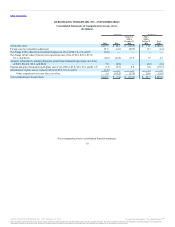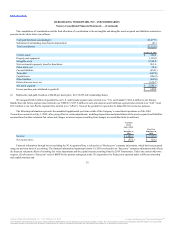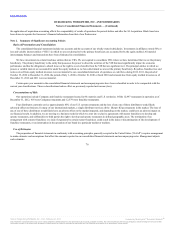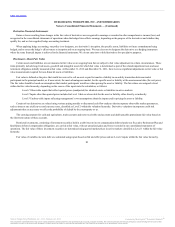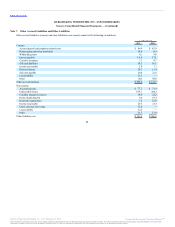Burger King 2012 Annual Report Download - page 79
Download and view the complete annual report
Please find page 79 of the 2012 Burger King annual report below. You can navigate through the pages in the report by either clicking on the pages listed below, or by using the keyword search tool below to find specific information within the annual report.
Table of Contents
Property and equipment, net, that we own are recorded at historical cost less accumulated depreciation and amortization. Depreciation and amortization
are computed using the straight-line method based on the estimated useful lives of the assets. Leasehold improvements to properties where we are the lessee are
amortized over the lesser of the remaining term of the lease or the estimated useful life of the improvement.
We classify assets as held for sale when we commit to a plan to dispose of the assets by refranchising specific restaurants in their current condition at a
price that is reasonable, and we believe completing the plan of sale within one year is probable without significant changes. Assets held for sale are recorded at
the lower of their carrying value or fair value, less costs to sell and we cease depreciation on assets at the time they are classified as held for sale. We classify
impairment losses associated with restaurants held for sale as losses on refranchisings.
If we subsequently decide to retain a restaurant or group of restaurants previously classified as held for sale, the assets would be reclassified from assets
held for sale at the lower of (a) their then-current fair value or (b) the carrying value at the date the assets were classified as held for sale, less the depreciation
that would have been recorded since that date.
We define a lease term as the initial term of the lease, plus any renewals covered by bargain renewal options or that are reasonably assured of exercise
because non-renewal would create an economic penalty.
Assets we acquire as lessee under capital leases are stated at the lower of the present value of future minimum lease payments or fair market value at the
date of inception of the lease. Capital lease assets are depreciated using the straight-line method over the shorter of the useful life of the asset or the underlying
lease term.
We also have net investments in properties leased to franchisees, which meet the criteria of direct financing leases. Investments in direct financing leases
are recorded on a net basis, consisting of the gross investment and residual value in the lease less the unearned income. Unearned income is recognized over the
lease term yielding a constant periodic rate of return on the net investment in the lease. Direct financing leases are reviewed for impairment whenever events or
circumstances indicate that the carrying amount of an asset may not be recoverable based on the payment history under the lease.
We record rent expense and income from operating leases that contain rent holidays or scheduled rent increases on a straight-line basis over the lease
term. Contingent rentals are generally based on sales levels in excess of stipulated amounts, and thus are not considered minimum lease payments at lease
inception.
Favorable and unfavorable operating leases are recorded in connection with the acquisition method of accounting. We amortize favorable and unfavorable
leases on a straight-line basis over the remaining term of the leases, as determined at the acquisition date. Upon early termination of a lease, the write-off of the
favorable or unfavorable lease carrying value associated with the lease is recognized as a loss or gain within other operating (income) expense, net in the
consolidated statements of operations. Amortization of favorable and unfavorable leases on Company restaurants is included in occupancy and other operating
costs in the consolidated statement of operations. Amortization of favorable and unfavorable income leases is included in franchise and property
78
Source: Burger King Worldwide, Inc., 10-K, February 22, 2013 Powered by Morningstar® Document Research℠
The information contained herein may not be copied, adapted or distributed and is not warranted to be accurate, complete or timely. The user assumes all risks for any damages or losses arising from any use of this
information, except to the extent such damages or losses cannot be limited or excluded by applicable law. Past financial performance is no guarantee of future results.




